I was fortunate to have the opportunity to visit the Filoli garden, near San Francisco, recently. The sky was blue, the birds were singing, and spring sunshine bathed the immaculate gardens in a soft, warm glow. As I strolled around this historic estate, I could not help but be impressed by the grandeur, reminiscent of the gardens surrounding English stately homes, with stone balustrades, brick pathways and distinct garden rooms.

Le jardinet
Yet the most memorable part of my visit was something on a much humbler scale: tulips. These vibrant spring flowers were abundant throughout the garden. Bold blocks of red, gold, pink and white filled beds and pots — a true celebration of the new season.
This outstanding 654-acre Californian jewel offers spring design ideas for all homeowners, no matter how large or small the garden. Here are some to get you started.
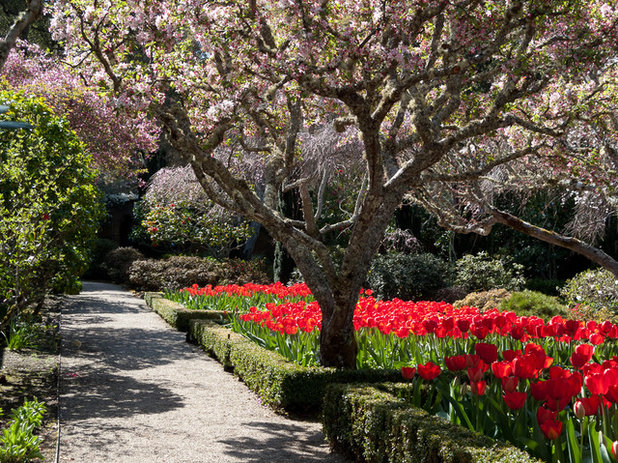
Le jardinet
Mass in the landscape. Tulips are at their most dramatic when planted en masse. A single variety fills each of these formal garden beds, which are defined by clipped boxwood hedges. Because they’re corralled in this way, the garden has structure, even when the bulbs are not in full bloom — an especially important consideration when they begin to decline.
Flowering cherry trees add height and an upper layer of color, while the shadows cast as the sunlight filters through their open canopy add to the ambience.
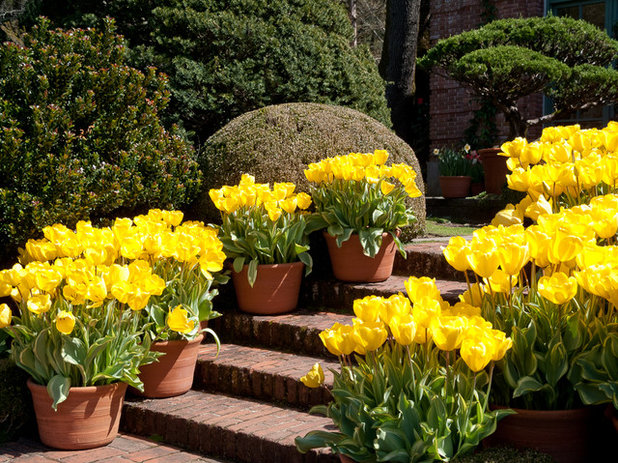
Le jardinet
Highlight a pathway. This is such an easy idea to try at home. In fall plant large pots (lightweight pots are best) with layers of a single tulip variety and allow them to grow in a sunny spot out of view.
When they are all well budded and beginning to bloom, bring them out to flank wide pathways. For a formal, structured look, place the pots directly opposite one another; this look is especially effective on steps, such as those shown here.
You can still create this looks even if you did not remember to plant tulip bulbs in fall. Nurseries and garden centers are well stocked in spring with pots of blooming bulbs. In many instances you can simply drop the nursery container into something more decorative at home, adding moss to disguise the top. It is also possible to gently replant these bulbs into larger containers.
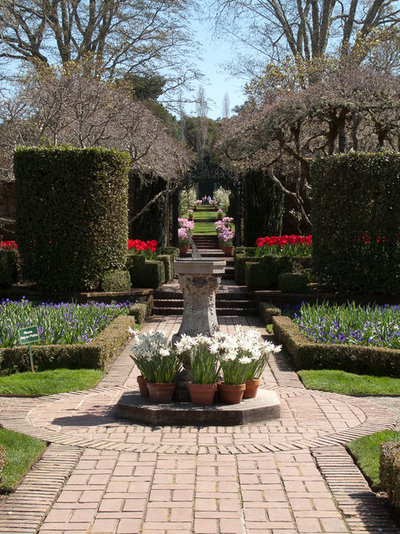
Le jardinet
This photograph shows how different colors of tulips draw the eye down a path through a series of garden rooms. Small, weathered terra-cotta pots with white daffodils sit at the base of a sundial in the foreground, while farther on mass plantings of red tulips fill boxwood parterres. In the distance, pots of pink tulips line the pathway itself, encouraging us to seek the final destination.
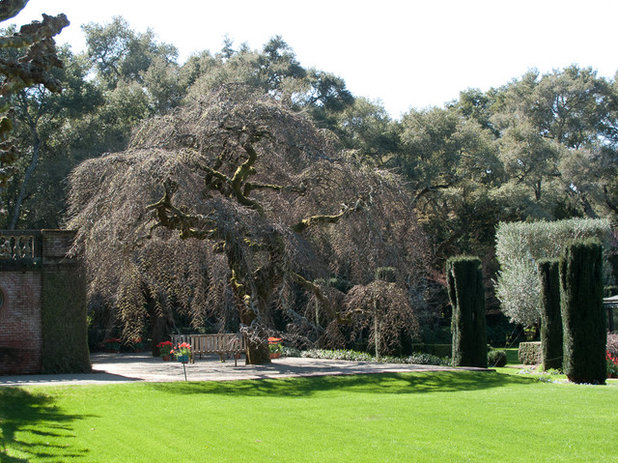
Le jardinet
Add color to patios. This old, gnarled camperdown elm is without a doubt one of the most
dramatic trees in the garden, especially in spring, when the intricate branching pattern is revealed. However, as beautiful as this tree is, one might have been tempted to appreciate it only from afar before moving on. Instead, pots of boldly colored tulips on the surrounding patio light up the scene and invite us into the space.
Does your patio look rather uninspiring at this time of year? This would be an easy way to freshen up the scene.
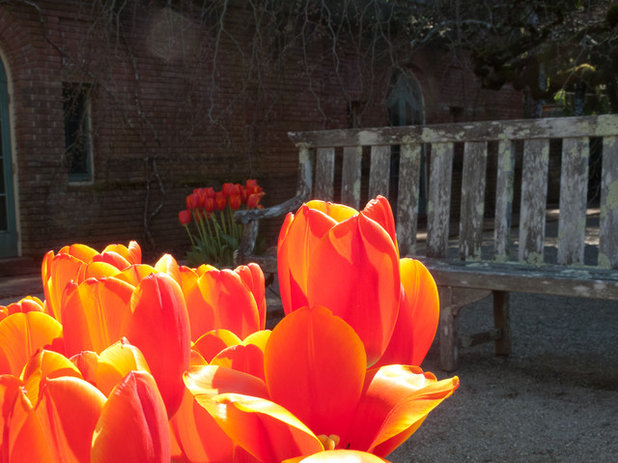
Le jardinet
Red and gold tulips explode like fireworks here. The juxtaposition of these smooth, vibrant blooms and the weathered benches encrusted with lichen is picture-perfect.
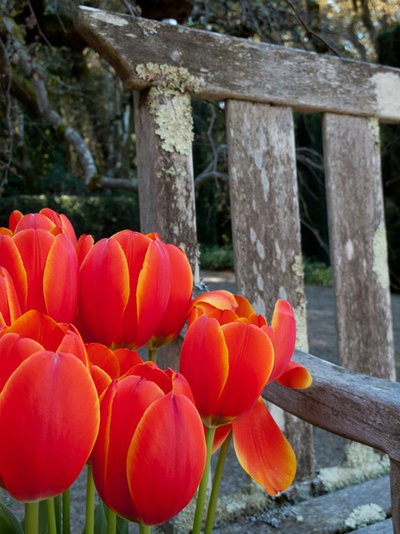
Le jardinet
This is such a simple idea that takes only moments to compose, yet it transforms the sleeping patio into a spring destination.
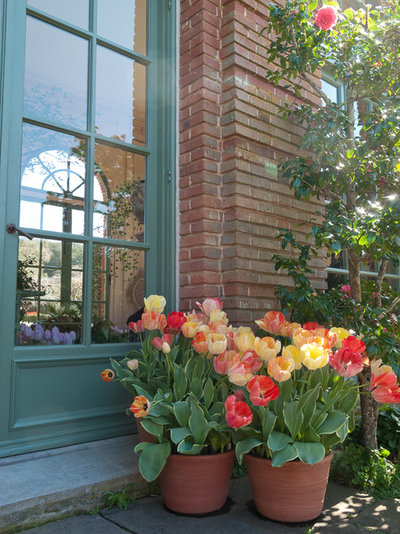
Le jardinet
Cluster pots in a doorway. An informal group of pots welcomes visitors to the conservatory. The soft blended colors of the tulips and pots are perfect against the aged bricks.
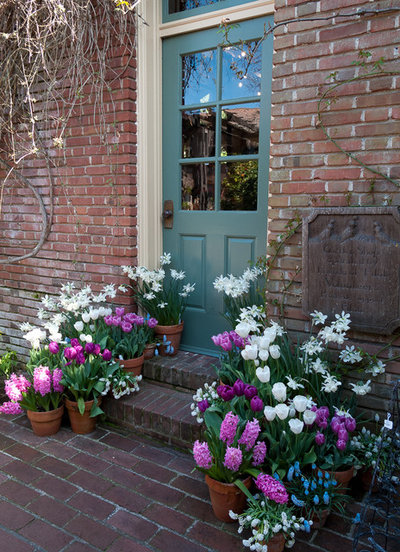
Le jardinet
Perhaps, like me, you have lots of small terra-cotta pots that are gathering dust in the potting shed. This is a wonderful way to use them. Hyacinths, daffodils, tulips and grape hyacinths have been planted in individual pots, then clustered together to create an instant spring garden.
A delicate white and pink color scheme adds a romantic, feminine touch to this courtyard.
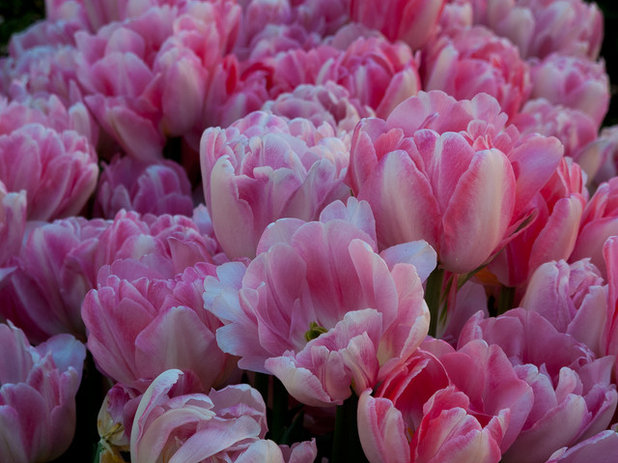
Le jardinet
Tulip Planting TipsWhen to plant: Plant bulbs in fall before a frost. In the Pacific Northwest, we usually do this in October or early November.
Light requirement: Full sun
Water requirement: Average
Soil: In the ground tulips need well-drained soil that is loose and fertile. For containers choose a well-drained potting mix that does not contain water retention polymers.
Fertilizer: Add bulb food at the base of the planting hole to promote root growth.
Spacing: The depth and distance between bulbs depends on their size; see individual packets for instructions.
Care: Remove flowers when they fade to prevent seed formation. In many areas tulips are treated as annuals. Where they are reliably perennial, allow the foliage to die down and turn yellow before either lifting and storing or trimming and leaving in situ.
Pests: Squirrels love tulips. Try covering the bulbs with chicken wire or placing them in a special rodent-proof cage.
See what to do in your garden now





